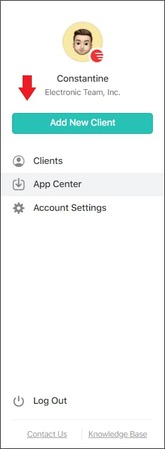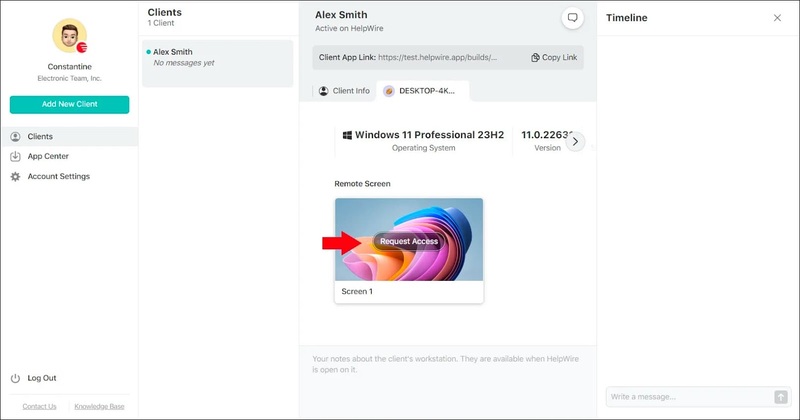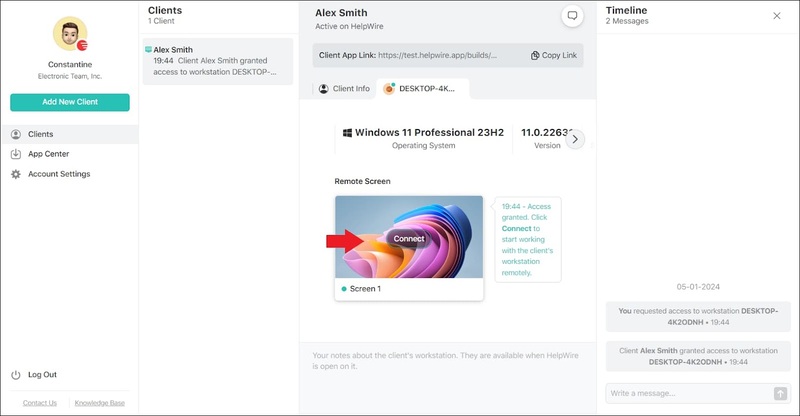How to Enable Remote Desktop on Windows 10/11 Home
- HelpWire
- →
- Blog
- →
- Definitive Guide to using Microsoft Remote Desktop
- →
- Remote Desktop for Windows 10/11 Home
Windows 10/11 Pro and Enterprise versions support Remote Desktop Protocol (RDP) as both a client and a host.
But Windows 10/11 Home can only act as a client to connect to remote desktops running on other Pro or Enterprise machines, and not the host for incoming RDP connections.
Tools, such as RDP Wrapper, can help bypass this limitation, but come with security risks. It can also break after software updates.
So, if you are looking for a workaround with RDP Wrapper and wish to know the risks, read on. But if you want to skip security risks and Microsoft policy violations and still perform remote desktop access on Windows Home version, you can use an alternative solution – HelpWire.
Windows 10\11 Home RDP: Limitations
Remote Desktop Protocol (RDP) works as a client and server.
- – RDP Server: Also known as the host or the computer that one can access remotely. The RDP server runs applications and provides a desktop interface for operations.
- – RDP Client: Also known as the client or the computer that starts the remote connection and tries to connect with the remote computer. The RDP client controls the host computer.
By default, RDP Server functionality is disabled in Windows 10/11 Home. This prevents you from connecting to these systems through Microsoft’s built-in Remote Desktop. Users, such as home lab users or remote workers, who seek remote access Windows 11 Home may find this limitation annoying.
That said, the core RDP elements are still not completely gone from Windows Home. Microsoft has kept the RDP service (termsrv.dll), but it can’t accept incoming remote connections. This means Windows Home can act as a client but not a host.
Users who need host functionality on Windows Home use workarounds, such as RDP Wrapper. This tool uses a configuration layer or a custom DLL without file modifications or pushing you to upgrade to Windows Pro.
How to Configure Remote Desktop on Windows Home
If you’re looking to understand how to set up remote desktop Windows 10 Home or 11 to be able to accept RDP connections, you can use RDP Wrapper, which could be risky.
RDP Wrapper: Known, Yet Risky Shortcut
The open-source tool, RDP Wrapper, is a utility that you can use to set up remote desktop connections on your computer running the Windows Home edition. However, Microsoft doesn’t officially allow this unless you use the higher version of Windows Pro or Enterprise.
The way RDP Wrapper works is by creating a “wrapper” around the existing components. This allows you to make Windows Home a host for accepting incoming remote desktop connections without having to modify any system files. Users who need remote access on their Windows Home computer find this pretty convenient as well as cost-effective, as they don’t have to pay for the license upgrades.
Look at this Reddit thread that captures users’ experiences with this workaround.
“I used this program so called RDPWrapper which basically allows me to connect… without forcing active users to log off.”
— Reddit /r/sysadmin“I just set it up today on Win10 2004… I just ran that and it worked.”
—Reddit /r/selfhosted
This goes without saying: no technology is perfect. RDP Wrapper has its limitations in terms of security and functionality.
RDP Wrapper is maintained by its developer community and is not officially recognized by Microsoft. Users report that it often breaks after updates and triggers antivirus alerts. Its use (particularly in business) could introduce security risks or compliance concerns.
Let’s understand some risks and limitations of using RDP Wrapper in the next chapter.
RDP Wrapper: Risks and Limitations for Remote Desktop Access
RDP Wrapper is popular and allows users to access remote desktop connections directly from their Windows Home editions. But it doesn’t sit well with Microsoft’s licensing terms. Plus, this community-maintained tool can break unexpectedly and invite security and compliance risks. This is not ideal in business environments, especially those heavily regulated.
1. Hidden Backdoor
RDP Wrapper uses a custom rdpwrap.dll file to inject itself into the RDP stack of Windows, instead of modifying system files. This way, the tool bypasses Microsoft’s licensing restrictions so users can receive incoming remote desktop connections on the Windows Home Edition.
But in the process of RDP Windows 11 home connection, your computer could be exposed to new vulnerabilities if the RDP Wrapper is not configured properly or not updated regularly. If hackers can detect these vulnerabilities before you do, they can exploit them to access your systems and files.
“RDP Wrapper adds a weakness to the system… opens a gateway for potential hackers to attack… leaving Windows OS in a more vulnerable state is an invitation for threat actors to attack.”
— NComputing
Also, many security vendors flag it as malware or riskware because it’s unofficial.
“I am installing RDP Wrapper on my machine, and the antivirus is deleting it… added exclusions… keeps deleting it.”
— ESET Forums
Security concerns with using RDP Wrapper are real for so many users. This is frequently discussed in many online forums and communities, such as Security Stack Exchange. Users have discussed that using RDP Wrapper with poor patches and outdated versions brings vulnerabilities in addition to those that RDP poses.
2. Instability After Updates
Because RDP Wrapper relies on system memory addresses and calls, Windows updates often break it. Users report frequent malfunctions:
“RDP Wrapper not yet working with Creators Update”
— Reddit /r/Windows10“RDP wrapper not working with error 126”
— Reddit /r/BeeSwarmSimulator“I can’t get the RDP wrapper to work.”
— Reddit /r/WindowsHelp
This forces users to hunt GitHub for fixes and apply constant troubleshooting. It’s unreliable for production use and unsuitable for non-technical users.
3. Microsoft’s Terms Violation
RDP Wrapper enables host connections on Windows Home, which Microsoft restricts. This violates its licensing terms and could create compliance issues, especially for businesses.
“RDP Wrapper is both illegal and unsafe to use.”
— ESET Forum
Microsoft hasn’t cracked down yet, but enterprise users risk penalties and reputational harm if enforcement begins.
4. Need for Technical Expertise
RDP Wrapper isn’t plug-and-play. Non-tech users may face cryptic errors like “Listener state: not supported.” Even experienced users must dig through GitHub threads, wikis, and config files to keep it running. Maintenance is ongoing, especially after Windows updates.
“Frustrated with Remote Desktop on Windows 10 Home (use at your own risk)”
— Reddit /r/Windows10
5. Dangerous for Inexperienced/Non-tech Users
Without proper configuration, exposed RDP ports or weak authentication can give attackers easy entry. Some malware even installs RDP Wrapper silently, providing attackers with backdoor access.
“RDP Wrapper can be dangerous if it appears on your system without your knowledge.”
— Reddit /r/antivirus
The fact that both legitimate users and hackers use it underscores the risk, particularly for inexperienced users.
How to Enable RDP Wrapper on Windows Home
If you wish to understand how to enable remote desktop Windows 10 Home (or 11 Home), follow these steps:
-
Step 1: Download RDP Wrapper
• Visit the RDP Wrapper project on GitHub:
🔗 https://github.com/stascorp/rdpwrap/releases• Under Releases, locate the latest .zip file and download it.
• Once downloaded on your computer, extract the archive to a folder.
-
Step 2: Install the RDP Wrapper Tool
• Right-click
install.bat. Select the Run as Administrator option.• It will initiate the installation process. Once it completes, the core DLL (
rdpwrap.dll) along with the necessary files will be installed on your system. -
Step 3: Update
rdpwrap.iniYou will now need to update the configuration file (
rdpwrap.dll) to support the latest version of Windows. Follow these steps:• Open the updated
.inirepository on GitHub:
🔗 https://github.com/sebaxakerhtc/rdpwrap.ini• Click rdpwrap.ini > Raw. Save this file.
◦ From your RDP Wrapper installation folder, replace the previous rdpwrap.ini:
pgsql
CopyEditC:\Program Files\RDP Wrapper\(or
C:\Program Files (x86)\RDP Wrapper\depending on your system) -
Step 4: Verify RDP Wrapper Installation
• From the same folder, run
RDPConf.exe.• All statuses should be in green:
◦ Wrapper: Installed
◦ Service: Running
◦ Listener: Listening
◦ Supported: YesIn case ‘Supported’ shows No, reload the updated .ini. Alternatively, check your Windows build in GitHub issues.
-
Step 5: Try Connecting from Another Computer
• Press
Win + R. Typemstsc. Press Enter. Do this on another Windows computer.• Input the Home PC’s IP address or name.
• On the remote machine, log in with your username and password.
Windows 10/11 may still display RDP as unavailable even after you install RDP Wrapper. But you can still accept remote connections from your Windows Home Edition with this method. Our tests confirm this.
Remote Desktop Alternative for Windows Home
As you might recall, using RDP Wrapper allows remote access on Windows Home. But many users have encountered functionality issues and security risks with this workaround. It may also violate Microsoft’s terms of use and raise compliance issues.
To prevent this, you may want to use third-party tools, such as HelpWire.
HelpWire is a free remote desktop software solution that allows you to enable remote access functionality on your computer running Windows Home. It’s an easy-to-use tool that offers security and plenty of remote support features, without violating Microsoft’s terms. HelpWire provides encrypted remote access for Windows 10/11 Home, preventing the need to modify system files. This way, it’s a safer and more practical alternative to RDP Wrapper for remote connections.
HelpWire at a glance
-
Free for personal and commercial use
-
Safe authentication
-
Enterprise-level encryption
-
Share the URL to start a remote session
-
Zero firewall modifications
Enable Remote Desktop on Windows 10/11 Home Using HelpWire
-
From your HelpWire account, choose ‘Add New Client’.

-
It will automatically generate a remote connection link. Share this link with the client. The user at the client side will use this link to download the HelpWire Client application on the client computer.

-
Wait for them to download and install HelpWire Client. Once done, they can open HelpWire’s application, while you can send a remote connection request to access the client computer.

-
Once you’ve gained the client’s permission, initiate a direct connection to the client system by clicking on ‘Connect’.

RDP Wrapper vs HelpWire
Let’s compare RDP Wrapper and HelpWire based on various parameters.
| Parameter | RDP Wrapper | HelpWire |
|---|---|---|
| Setup | Complex, needs regular maintenance and manual installation | Very easy, without manual configuration |
| Security | Security risks and vulnerabilities may pop up after Windows updates | Higher connection security with end-to-end encryption |
| Functionality | Major Windows updates can break functionality or stability | A cloud-based tool, offering consistent functionality. No effects after updates. |
| Platform Support | Limited | Cross-platform support (Windows, macOS, and Linux) |
| Free | Yes | Yes |
| Updates | Requires manual fixes after updates | Automatic updates |
Final words
RDP Wrapper is a popular tool to enable remote desktop connections on Windows Home Edition. However, it comes with many limitations, such as functional instability after Windows updates, security risks, and Microsoft licensing violations.
If you’re searching for a more secure and stable solution without violating Microsoft’s terms, HelpWire is the best option. This free, cloud-based software provides consistent remote access and automatic updates without the hassles of manual installation or maintenance.
Whether you’re a business or home user, you can benefit from HelpWire’s powerful remote desktop software that supports major platforms and is easy to set up and use.